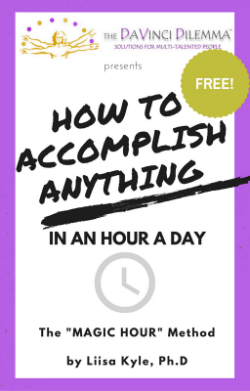So you’ve decided. To clear your mind, reconnect with your talent and/or make real progress on that project that needs a jump-start, you are going to go away on your own solo retreat! (Click here for the “Part 1” post on this topic.) Before making your escape, you’ll need to lay a little groundwork both externally (husbands, wives, bosses, vacation time) and in your own head. Here are some tips from a fellow traveler who’s been there to help you design a productive and satisfying solo retreat.
Planning Your Solo Retreat
1. Decide on a time frame that works for you. I went for a week, but depending on your work, financial or family obligations, you may find a four days or even just a weekend more practical. If you make it shorter, perhaps you can plan to do it more often, say once a quarter.
2. Decide what you want to accomplish. I wanted to set a goal finish my script, but a friend pointed out that a better outcome to shoot for might be a page count or some other incremental benchmark so that I could give myself a better chance of hitting my target. Plan a goal that’s challenging but do-able, so you’ll feel excited, not overwhelmed. I decided a win would be 50 new pages, so writing 80 was a triumph.
3. Decide what you don’t want. Distractions like TV or Twitter, needing to check in with the office, calling friends to whine during the day…what might make you less effective during this important time with yourself? Make sure to set yourself up ahead of time so that these are not a part of your retreat. A vital part of this is to prepare loved ones for your being off the grid. Call people you are close to and ask for their support. For everyone else, set an autoresponder on your email that you are going to be out of communication until you return…and that for emergencies to call your cell phone. Do NOT include your cell phone number in this auto-response. The people who really need to reach you in emergencies already have it. The rest can wait. Also, decide what emotions you don’t want and banish them. Guilt, worry, self-doubt — these were not coming along for the ride.
4. Find a location that fits your goals and budget. You can do a solo retreat pretty much anywhere — except your home. Locking yourself in the bedroom or garage won’t cut it; you really MUST leave your normal environment and go somewhere else for this to work, and preferably stay away at least one night. But it doesn’t have to be a fancy hotel. Get creative. Look for a place within driving distance, or that you can get to cheaply. Can you apartment-sit for a friend while she’s on vacation? You can often even rent a room in a monastery or a convent for very little. On the other hand, if you want something a bit more comfortable, some hotels and time-share resorts do have suites they rent at a discount off-season and during the week. This is my preference. Look for one with a kitchen so you can save on going out to eat (and you may not enjoy dining alone in public anyway). You can find some amazing last-minute deals on the internet. People also rent out their time share apartments on Craigslist and ebay.
Once you’ve set the stage, here are some bonus suggestions on how to get the most out of the experience before, during and after.
How to make the most of your solo retreat
1. Choose and maintain the right “work-life balance” for you. Some people can feel comfortable all alone in a cabin in the woods miles from anywhere, while others may feel the walls closing in, or stare at the door expecting a visit from the Unabomber. Some can stay in a bustling city and get work done, while others may not be able to resist the call to play tourist, party or shop instead of working. Sedona for me was perfect, with the right mix of “stuff to do” and peace and quiet. It was ideal because I could walk outside at anytime and take a hike in gorgeous nature, but there wasn’t so much going on that I felt like a hermit stuck in my garret and missing all the fun. The mountains weren’t going anywhere. And there was one artists’ gallery party during the week where I got to interact with the somewhat kooky locals. If you need and enjoy total isolation, then go get it – but if you’re like me you may find you need a wee bit human contact, or at least the possibility of it, to keep from going crackers.
2. Start your retreat as soon you get in the car.Or on the train, plane or bus. Don’t wait till you get to your destination. I stocked my car’s DVD player with inspirational music, motivational speakers, screenwriting instruction CDs and interviews with my favorite writers. My DaVinci Dilemma™ co-author, Liisa Kyle Ph.D, gave me the genius idea of having a digital voice recorder handy so I could capture my thoughts and ideas as I drove. This allowed me not only to start thinking right away and making the best use of my time, but when I got to my retreat site, there was no standing around wondering where to start, or what was I doing here in the first place. I was already cooking.
3. Have an accountability partner. I told all my friends, family and my Twitter and Facebook network that I was going off the grid for a week, and I religiously didn’t make or take phone calls during the day. However, before I left, I made arrangements with one fellow writer and coaching colleague to call her every night around 6PM and report on my day’s progress. It helped keep me on track, validated a sense of accomplishment at the end of the day, and gave me perspective an encouraging shoulder to cry on when things didn’t go well. Note: choose this person carefully. In my opinion, it’s better if it’s not your significant other, but a coach or someone who is also an artist and really gets where you’re coming from. I was lucky to find both in the same person.
4. Structure your time. I had a stack of multi-colored post-it notes that I put on the mirror in the living room where I worked, where I planned “chunks” of time for work (yellow), meals (blue), refreshing walks in the mountains (green), treats like a hot tub soak, time for painting watercolors, movie-night and calls home (purple). You might schedule a massage or some other reward. The post-its allowed me to move things around, trading a movie for a hot tub session, for example. As long as I was getting all my “work chunks” done, I was on track.
5. Make time for the Big Picture. You know all those vision boards you always say you’re going to work on when you have time? Now is the perfect time to plan that activity. Bring art supplies, photos ripped from magazines, music…everything you’ll need to get creative and inspired. Besides helping you visualize what you want, the result will also serve as a great anchor/reminder of your retreat when you are back in the “real” world.
6. Have “re-entry” strategy.How will you maintain your progress after you get back to the “real world”? What are your next steps? What habits do you want to establish? Now — either before or during your retreat — is the time to strategize your actions so you don’t find yourself stalled again a few weeks or months later, after having gotten caught up in the day-to-day routine.
Activity: Map out your own perfect solo retreat, whether you plan to actually take one soon or not. Where might you go? For how long? How would you manage being “off the grid?” How could you begin your retreat as soon as you left the house? What could you bring with you to help? On whom would you rely for support? What do you think would be your biggest challenge and how would you solve it? How could you maintain your progress after you came home?
If you could go anywhere on a solo retreat, where would it be? Share your ideas below with your fellow DaVincis!
*****
If you’d like to share or publish this article, you may, if you include the author’s name, a link to this original post and the following text blurb:
Are you struggling with too many talents, skills, ideas? You may have The Da Vinci Dilemma™! Find tools, fun quizzes, coaching, inspiration and solutions for multi-talented people at http://www.davincidilemma.com/.



